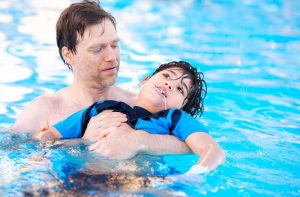Aquatic Therapy
WHAT IS AQUATIC THERAPY AND WHY IS IT IMPORTANT?
WHAT IS AQUATIC THERAPY AND WHY IS IT IMPORTANT?
Aquatic therapy uses the properties of the water, strategies, techniques and equipment to;
Students with additional needs and/or challenging behaviours benefit from aquatic therapy in numerous ways.
The water has a calming effect on students with additional needs. By using the properties of the water, the warmth of the water, and certain techniques during our sessions, students’ anxiety levels, for example, are visibly reduced. They are calmer, more focused and less overwhelmed. Also, because aquatic therapy at times requires bi-lateral movements, a student’s focus and concentration is continually tested and improved. More complex demands can be executed on demand over time.
The students are also learning pro-social skills when around a body of water. For example, this includes asking for parental consent to go into the water, awareness of surrounding people and hazards and ensuring calm and correct entries into the water. It is hoped that this will become an automatic response from the students when confronted with new bodies of water, especially for those attracted to water. Statistics show that children with ASD are 160 times more likely to drown than their neurotypical peers.
Aquatic Therapy, and the water’s property of hydrostatic pressure, also helps students regulate their emotions in a calm, appropriate manner which in turn helps in controlling their emotions. Learning how to self-regulate is beneficial when interacting with peers.
Most skills and concepts take much longer for students with additional needs to master. Being 1:1, the aquatic therapy sessions allow for repetition and extra time for learning as required, a change of pace if they become overwhelmed and the use of specialised equipment, techniques and strategies which support their learning/progress.
Gross and heavy full-body movements during aquatic therapy sessions improve the student’s strength and coordination as well as the development of fine and gross motor skills. This in turn can assist with independence in daily living skills such as holding a toothbrush, doing up buttons, or kicking a ball with friends.
Sometimes a picture board is used during the sessions. This is a visual structure of the session and the student moves through the pictures in order. This is helping the student initiate the next step and picture-by-picture progress through the session. This also can reduce a student’s anxiety levels as they know what is next and when the session will finish.
Equipment Used
The most common pieces of equipment used in aquatic therapy sessions are listed below. They are used to achieve proprioception development, improve muscle tone, core strength, co-ordination, feeling grounded, improve muscle tone, bi-lateral movements and crossing the midline, motor planning and fine and gross motor skill development.
Contact – Ruth Smith – 0448 649 150

If you would like to know how we could help you or those you know then contact us below. You can either submit some information for me to consider or leave a note for me to call you.